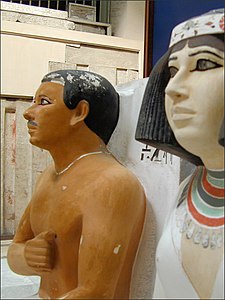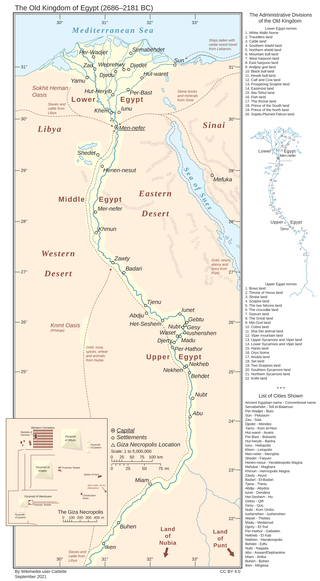
In ancient Egyptian history, the Old Kingdom is the period spanning c. 2700–2200 BC. It is also known as the "Age of the Pyramids" or the "Age of the Pyramid Builders", as it encompasses the reigns of the great pyramid-builders of the Fourth Dynasty, such as King Sneferu, under whom the art of pyramid-building was perfected, and the kings Khufu, Khafre and Menkaure, who commissioned the construction of the pyramids at Giza. Egypt attained its first sustained peak of civilization during the Old Kingdom, the first of three so-called "Kingdom" periods, which mark the high points of civilization in the lower Nile Valley.
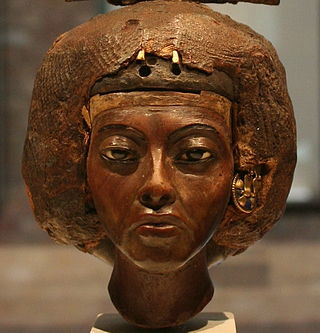
Tiye was the Great Royal Wife of the Egyptian pharaoh Amenhotep III, mother of pharaoh Akhenaten and grandmother of pharaoh Tutankhamun; her parents were Yuya and Thuya. In 2010, DNA analysis confirmed her as the mummy known as "The Elder Lady" found in the tomb of Amenhotep II (KV35) in 1898.
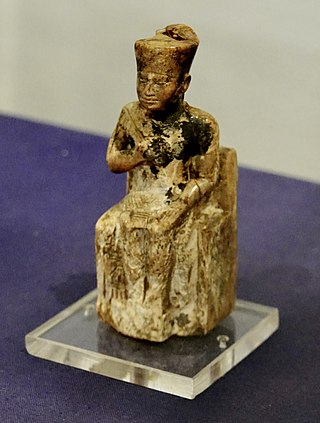
Khufu or Cheops was an ancient Egyptian monarch who was the second pharaoh of the Fourth Dynasty, in the first half of the Old Kingdom period. Khufu succeeded his father Sneferu as king. He is generally accepted as having commissioned the Great Pyramid of Giza, one of the Seven Wonders of the Ancient World, but many other aspects of his reign are poorly documented.

The Fourth Dynasty of ancient Egypt is characterized as a "golden age" of the Old Kingdom of Egypt. Dynasty IV lasted from c. 2613 to 2494 BC. It was a time of peace and prosperity as well as one during which trade with other countries is documented.

Huni was an ancient Egyptian king, the last pharaoh of the Third Dynasty of Egypt during the Old Kingdom period. Based on the Turin king list, he is commonly credited with a reign of 24 years, ending c. 2613 BC.

Neferirkare Kakai was an ancient Egyptian pharaoh, the third king of the Fifth Dynasty. Neferirkare, the eldest son of Sahure with his consort Meretnebty, was known as Ranefer A before he came to the throne. He acceded the day after his father's death and reigned for eight to eleven years, sometime in the early to mid-25th century BCE. He was himself very likely succeeded by his eldest son, born of his queen Khentkaus II, the prince Ranefer B who would take the throne as king Neferefre. Neferirkare fathered another pharaoh, Nyuserre Ini, who took the throne after Neferefre's short reign and the brief rule of the poorly known Shepseskare.

Menkauhor Kaiu was an Ancient Egyptian pharaoh of the Old Kingdom period. He was the seventh ruler of the Fifth Dynasty at the end of the 25th century BC or early in the 24th century BC.
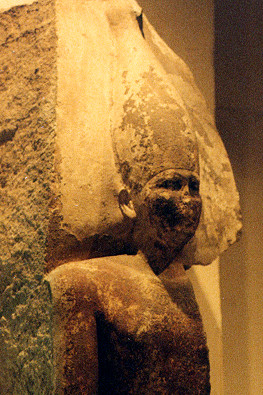
Sneferu, well known under his Hellenized name Soris, was the founding pharaoh of the Fourth Dynasty of Egypt during the Old Kingdom. Estimates of his reign vary, with for instance The Oxford History of Ancient Egypt suggesting a reign from around 2613 to 2589 BC, a reign of 24 years, while Rolf Krauss suggests a 30-year reign, and Rainer Stadelmann a 48-year reign. He built at least three pyramids that survive to this day and introduced major innovations in the design and construction of pyramids.

Queen Meresankh III was the daughter of Hetepheres II and Prince Kawab and a granddaughter of the Egyptian pharaoh Khufu. She was the wife of King Khafre.

Nefermaat I was an ancient Egyptian prince, a son of king Sneferu. He was a vizier possessing the titles of the king's eldest son, royal seal bearer, and prophet of Bastet. His name means "Maat is beautiful" or "With perfect justice".
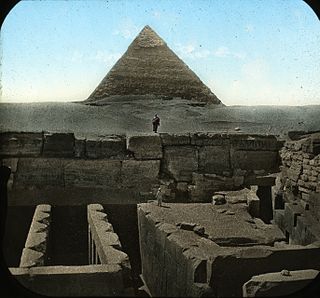
Minkhaf I was an ancient Egyptian prince of the 4th Dynasty. He was a son of Pharaoh Khufu, half-brother of Pharaoh Djedefre and elder brother of Pharaoh Khafre. His mother may have been Queen Henutsen. Minkhaf had a wife and at least one son, but their names are not known. Minkhaf served as vizier possibly under Khufu or Khafre.
Djedefhor or Hordjedef was a noble Egyptian of the 4th Dynasty. He was the son of Pharaoh Khufu and his name means "Enduring Like Horus".
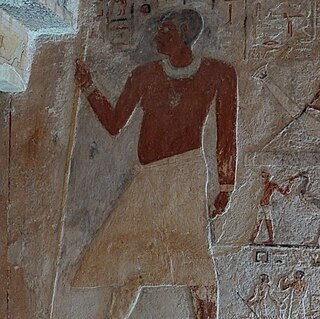
Kawab is the name of an ancient Egyptian prince of the 4th Dynasty. He was the eldest son of King Khufu and Queen Meritites I. Kawab served as vizier and was buried in the double mastaba G 7110–7120 in the east field which is part of the Giza Necropolis.

Henutsen is the name of an ancient Egyptian queen consort who lived during the 4th dynasty of the Old Kingdom Period. She was the second or third wife of pharaoh Khufu and most possibly buried at Giza.

Ranefer was a prince of ancient Egypt during the 4th Dynasty.
Netjeraperef is the name of an ancient Egyptian high official and prince. He lived and worked at the transition time between 3rd and 4th Dynasty during the Old Kingdom period.

Nofret was a noblewoman and princess who lived in Ancient Egypt during the 4th dynasty of Egypt c. 2613 to 2494 BC. Nefert means "beautiful". Nofret is alternatively known as Nefert or Neferet.
The High Priest of Ra or of Re was known in Egyptian as the wr-mꜢw, which translates as Greatest of Seers.

The ancient Egyptian noble Prehotep II was Vizier in the latter part of the reign of Ramesses II, during the 19th Dynasty.

Seneb was a high-ranking court official in the Old Kingdom of Ancient Egypt, circa 2520 BC. A dwarf, Seneb was a person of considerable importance and wealth who owned thousands of cattle, held twenty palaces and religious titles and was married to a high-ranking priestess of average size with whom he had three children. His successful career and the lavishness of his burial arrangements are indicative of the acceptance given to dwarfs in ancient Egyptian society, whose texts advocated the acceptance and integration of those with physical disabilities.


